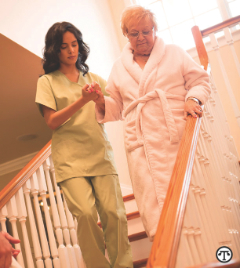 (NAPSI)—Falls can become more common and more serious as people age. The good news is that there are steps you can take to help prevent them. Here are some tips.
(NAPSI)—Falls can become more common and more serious as people age. The good news is that there are steps you can take to help prevent them. Here are some tips.
• Identify the health factors that can increase your risk for falling—poor eyesight, reduced reaction time, a decline in muscle strength, and limited movement can all contribute to putting a person at risk for falling—particularly if they are ignored.
• Don’t be afraid to use a cane or walker if you are feeling unsteady—and promptly replace worn rubber tips of these devices.
• Be careful around pets. They can get underfoot or jump on you.
• Don’t leave clothes or newspapers on the floor.
A Safety Checklist
Falls are often due to hazards that are easy to overlook, but many times, they are just as easy to fix. Interim HealthCare has developed a checklist that can be used to help you find and fix hazards in your home.
Go through the list and check off each item that describes the situation in your home. Each item that gets checked represents a step you have taken to reduce a potential hazard. Here are a few examples:
Bathroom Safety
• There are grab bars on the bathroom walls, near the toilet or along the bathtub or shower.
• A slip-resistant rug is next to the bathtub or shower.
• A mounted or suction liquid-soap dispenser is on the bathtub/shower wall.
• Nonskid adhesive-textured strips are on the bathtub/shower floor.
• A sturdy plastic seat (shower chair) is placed in the bathtub.
• There is a raised toilet seat or a toilet seat with armrests to maintain balance when getting on or off the toilet.
• An extra-long mirror is over the sink so it can be used when sitting.
Bedroom Safety
• Clutter is cleared from the floor so that nothing is in the way.
• A lamp, flashlight and telephone are within easy reach near the bed.
• Night-lights are placed along the path from the bedroom to the bath.
• A raised mattress is available to get in and out of bed easily.

